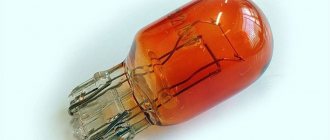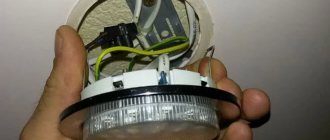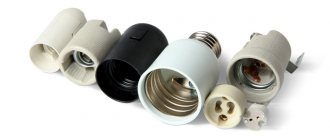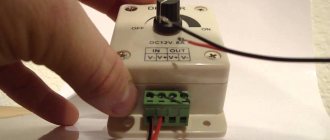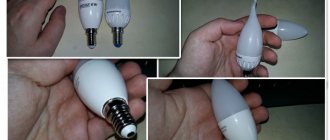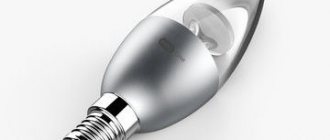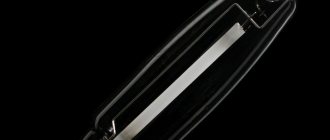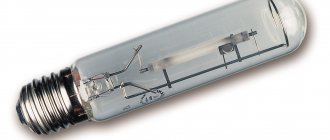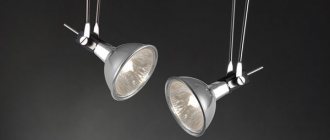You can illuminate your home, place of work, street and other objects using several dozen different types of lamps. They differ in type, power, purpose, base shape and other characteristics. Let's look at the features of incandescent, fluorescent, infrared, quartz, ultraviolet, sodium, and other types of lamps used by people for various purposes.
The most commonly used shapes of light bulbs in everyday life Source happymodern.ru
Edison base
One of the most common types of sockets for an incandescent lamp or LED light bulb is the Edison socket, which has a screw thread. The marking of each such E-lamp, in addition to the letter “E”, also includes a digital designation. It shows the size (diameter) of the thread in millimeters. There are ten dimensional types of E-bases:
- E5 – for switchboards, foreign household appliances (voltage 6 V, 14 V and 28 V);
- E10 – for ovens, refrigerators, Christmas tree garlands;
- E11 – for medical equipment (voltage 24 V);
- E12 - for foreign-made chandeliers (voltage used - 220 V);
- E14 or “minion” - for ordinary lamps and fixtures;
- E17 - American lamps designed for voltage 110-120 V;
- E26 - a light bulb intended for low voltage in Russia (as the previous option);
- E27 is the most common format (available in different powers - for example, 40 W, 60 W, 75 W, 100 W);
- E39 - large light bulbs for low voltage.
Closing the list is the “E40” type of lamp, the base format used in Russia, often found not only on E-incandescent lamps, but also on gas-discharge, sodium lamps.
Sodium lamp with E40 base Source cs9.pikabu.ru
Incorrect connection of the lamp
Another reason why LED lights glow may be incorrect connection of the switch and the lamp. If the lamp is connected in such a way that the switch breaks not the phase, but the neutral wire, then when the switching device is turned off, the lamp remains energized, and any leak in the neutral wire leads to the fact that the lamp barely burns or flashes periodically.
Important! This situation is unacceptable from a security point of view. During any repair work there is a risk of receiving an electric shock, even when the switch is turned off.
Other types of bases
In addition to light bulbs with an “Edison” base, other types are widely used in everyday life and in industrial enterprises.
Bayonet
The lamp base used for placement in moving objects is called bayonet, bayonet or pin (type “B”). A special feature of the base mounting in such a light bulb is the “insert-turn” mechanism, which allows you to quickly and firmly attach the light source without a long screwing process.
The designation of the base type, in addition to “B” and the number defining the diameter, may contain another letter. It is needed to determine the number of contacts (“p” - five, “q” - four, “t” - three, “d” - two, “s” - one) or the scope of application (“BA” indicates a car light bulb).
Two-bayonet
The variety of lamp base types includes two-pin connectors marked as “G”. Moreover, the second Latin letter in the name denotes various modifications of this lighting element. Thus, with the help of such encryption, names designate lamps with long, short, rounded pins, or having a special shape (for example, like a bactericidal G-bulb).
Light bulb with G23 connector Source alicdn.com
Single-bayonet
A lamp with one “bayonet” is marked “F”. In this case, there are three modifications in the form of this single contact:
- “a” – cylindrical;
- “b” – corrugated (out of use);
- “c” is special.
The numerical value after the letter determines the thickness of the pin in millimeters.
R-base
A light bulb whose contact element is recessed. It is similar to a single-butt connector (the previous type of base), and is securely connected to the contact thanks to spring protrusions. These important elements perform two functions at once: fixing the light bulb during its operation and creating high-quality contact (electrical commutation).
Soffit plinth
Identified by the letter "S" and may have the same base contacts on both sides. The soffit mounting option is used to illuminate car interiors, license plates (in the automotive industry), and electrical equipment. The maximum size (diameter) for a soffit base is 1.9 cm.
Cable
To make the connection universal, a cable socket (type “K”) is sometimes used. Lamps with contacts instead of threads are used to illuminate large rooms or spaces using a special powerful lamp.
Some DRSh lamps have an additional contact on the side - for igniting the arc Source sseg.ho.ua
Xenon
Xenon (type “H”) light sources are used where very precise positioning of the light source is required (for example, to focus light in car headlights). The connector for such a lamp is special; it may have modifications according to the diameter of the base.
A large number of types of lamps and sockets are used in cars Source sovet-ingenera.com
Flanged
Flange, focusing or fixing (“P”) sockets are used in the socket of a light bulb, which must be very precisely connected to the source of electricity and directs the light beam in the desired direction, that is, it is focused. Flange bases differ greatly in shape.
See also: Catalog of companies that specialize in electrical work and lighting.
Telephone socket
The so-called telephone socket can be found in the light bulbs of the switchboard and control panel. This type of fastening is designated by the letter “T”.
Electrical wiring faults
One of the reasons why LED lamps glow is the natural aging of electrical wiring and the appearance of leaks through the insulation. This can cause tension to appear in completely unexpected places. In most cases it is small, but enough for the LED device to glow faintly.
Old aluminum wiring, laid in a hidden way, after 30 years of operation.
The insulation condition can be checked with a megger (checking with a multimeter in most cases is a waste of time due to the low measuring voltage). For a 220 V network, the insulation resistance should not be less than 0.5 MOhm. But even if a deterioration in the condition of the insulation is detected, often nothing can be done - it is impossible to accurately determine the location of the damage. And since the electrical wiring in residential and public buildings is hidden, its complete replacement is carried out during a major renovation of the premises.
Expert advice
Starikov Mikhail
Senior Electronics Engineer
Ask a Question
When testing the insulation of a 220 V network, the megger voltage should be no more than 500 V. During the measurements, the load (lamp) must be turned off so that it does not fail when exposed to increased voltage. It is also necessary to disconnect the wires under test from the supply side (switch).
Effect of capacitive conductivity
It must be taken into account that the leak may be capacitive in nature. In this case, one plate of the capacitor is a wire, the other is a second wire, a grounded conductive element (fittings), a damp wall, etc. It is much more difficult to detect such a fault with a megger without experience. It must be borne in mind that this problem cannot be solved even by completely replacing the electrical wiring. The capacity will not go away from this, and moreover, it directly depends on the quality of the insulation.
The influence of parasitic capacitance between the neutral and phase wires.
Also, stray capacitance can cause unauthorized glow if there is voltage on the neutral wire relative to ground. Its source is voltage asymmetry in phases, characteristic of end-user networks (220 V). Through the interwire capacitance, this voltage creates a small current, at which the LED lamp lights dimly even when turned off.
And we should also note the influence of interference. There is a situation when another phase wire is laid parallel to a phase wire over a long distance and at a short distance. If a sufficiently powerful load is connected to it, the current flowing through such a conductor creates an electromagnetic field that induces voltage in the LED power wire. It may be enough to constantly or periodically light the LED.
Types of lamps
The types of light bulbs based on their method of operation collectively represent a very large list of varieties.
Incandescent lamp
The light from such a bulb is emitted by a filament body, which uses a refractory metal (for example, tungsten, which can withstand up to 3200 degrees Celsius). For durability, an inert gas such as argon is introduced into the glass part of the light bulb during manufacturing. The surface of an incandescent lamp can be regular, mirror or matte. The advantage of this type of lighting bulb is its excellent color rendering index, comfortable for people and similar to the sun.
LED
LED lamps or light emitting diode (LED) light bulbs operate on semiconductor crystals that turn into bright light through a “pn” transition process. Most often, conventional, popular LED lamps have about five diodes in one light source.
Color rendering index
The third parameter describes how colors are perceived under artificial light, because light can distort them. This is important not only for the designer’s work with color, but also in order to accurately see the color of clothing and makeup in the mirror. For example, if you have lamps with distorted color rendering, then a blouse that was burgundy in the store will turn out to be red-scarlet at home, or blondes will have a greenish tint in their hair.
The color rendering index can be specified in two ways: Ra and CRI (color rendering index). The number in this case is a percentage: so, 100% is the sun, and lamps are now capable of a maximum of 95%. For correct color rendering, the optimal value is at least 80 Ra/CRI. Unfortunately, Chinese manufacturers may indicate this data incorrectly, so if you don’t want to make a mistake, it is better to use lamps from well-known brands. If this index is not on the packaging, this clearly indicates an unreliable manufacturer - you can buy a pig in a poke.
Advantages and disadvantages
Incandescent lamps have their own advantages and disadvantages.
Advantages:
- Ease of manufacture. Therefore, their price is appropriate.
- Ease of use. There is no need to install additional elements when connecting to the network. Lamps with a power of 150 W are often used in lighting greenhouses. Their light is close to natural. In addition to illumination, they also provide warmth.
- Does not affect human vision.
- No warm-up time required.
- Withstands temperature changes.
- Dispose of as household waste.
- The composition does not contain harmful elements.
Flaws:
- Short service life.
- Dependence on power outages and frequent switching on/off is the cause of filament rupture in incandescent lamps. To eliminate voltage difficulties, stabilizers are installed.
- Low level of efficiency. This is due to the expenditure of most of the energy on heat.
- Fire hazard. Because heat builds up around the lamp.
- Fragility.
- There is a possibility of the housing rupturing, which can lead to injury.
When purchasing an incandescent light bulb, you should take into account all the advantages and disadvantages in order to avoid unpleasant factors during operation.
We recommend watching the video:
LEDs
An LED consists of two semiconductors. One of them has an excess of electrons, and the other, on the contrary, has a deficiency. When current flows through such a diode, excess electrons from the first semiconductor fall into the “holes” from the missing electrons in the second. During this transition, energy is released in the form of light.
For a long time, LEDs were used only as indicators in electrical devices because they were very dim. But with the advent of super-bright LEDs, the situation has changed. Now they are used in traffic lights, car headlights, flashlights, advertising screens and monitor backlights.
LEDs consume incredibly little energy, yet they are very bright and long lasting. The only drawback is the relatively high price, but this is also falling due to widespread distribution.
Characteristics
In a detailed description, we will take into account the following characteristics:
- base (cartridge) – place where the bulb is attached;
- color rendering;
- luminous efficiency (luminous efficiency);
Luminous output
Shows how many lumens the light source produces at 1 W. For example, a standard incandescent lamp has a light output of 10 lm/W, a fluorescent lamp has a light output of 70 lm/W, which means that at the same power, the latter will glow 7 times brighter.
When talking about light output, it is necessary to mention the so-called energy-saving technologies.
Essentially, energy saving means: we consume little, we shine a lot. In this context, sodium light sources have the highest energy efficiency (see comparison table).
However, it is customary to call either LED or fluorescent lamps energy-saving.
Color rendering index (Ra)
Shows how natural colors appear in the emitted light. The higher this number, the better the characteristics of the source, the closer its light is to natural light.
Qualitative gradations of the coefficient are shown in the table:
| Ra | color rendering quality |
| <39 | not enough |
| 40–59 | enough |
| 60–79 | Fine |
| >80 | Very good |
Colorful temperature
Determines the color of a luminous object, measured in degrees Kelvin (K). Depending on the temperature of the light, surrounding objects look slightly different.
An ordinary white sheet of paper can have shades ranging from warm and yellowish at 2500 K (candle), to brilliant blue at temperatures from 6500 K.
The following shades of light are distinguished:
| Color. temperature, K | Hue |
| 2700 – 3200 | warm white |
| 3200 – 4500 | neutral white (daytime) |
| 4700 – 6000 | white |
| more than 6000 | cold white |
Light of different temperatures has different effects on human perception (let’s remember theatrical productions and various installations, where light plays a significant role in conveying an emotional state).
Warm white (2700 – 4200 K) light helps you relax and puts you in a calm mood. Suitable for lighting bedrooms, living rooms and dining rooms.
Daylight (4200 – 5500 K) helps to concentrate on completing tasks; it is most suitable for office premises and for illuminating the work area (including the kitchen), and for dressing rooms.
Cool white light (5500 - 6000 K) is quite energetic, suitable for bathrooms, kitchens (work surface, but not dining table).
